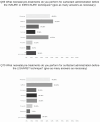A Survey of the Union of European Neonatal and Perinatal Societies on Neonatal Respiratory Care in Neonatal Intensive Care Units
- PMID: 38397269
- PMCID: PMC10887601
- DOI: 10.3390/children11020158
A Survey of the Union of European Neonatal and Perinatal Societies on Neonatal Respiratory Care in Neonatal Intensive Care Units
Abstract
(1) Background: Our survey aimed to gather information on respiratory care in Neonatal Intensive Care Units (NICUs) in the European and Mediterranean region. (2) Methods: Cross-sectional electronic survey. An 89-item questionnaire focusing on the current modes, devices, and strategies employed in neonatal units in the domain of respiratory care was sent to directors/heads of 528 NICUs. The adherence to the "European consensus guidelines on the management of respiratory distress syndrome" was assessed for comparison. (3) Results: The response rate was 75% (397/528 units). In most Delivery Rooms (DRs), full resuscitation is given from 22 to 23 weeks gestational age. A T-piece device with facial masks or short binasal prongs are commonly used for respiratory stabilization. Initial FiO2 is set as per guidelines. Most units use heated humidified gases to prevent heat loss. SpO2 and ECG monitoring are largely performed. Surfactant in the DR is preferentially given through Intubation-Surfactant-Extubation (INSURE) or Less-Invasive-Surfactant-Administration (LISA) techniques. DR caffeine is widespread. In the NICUs, most of the non-invasive modes used are nasal CPAP and nasal intermittent positive-pressure ventilation. Volume-targeted, synchronized intermittent positive-pressure ventilation is the preferred invasive mode to treat acute respiratory distress. Pulmonary recruitment maneuvers are common approaches. During NICU stay, surfactant administration is primarily guided by FiO2 and SpO2/FiO2 ratio, and it is mostly performed through LISA or INSURE. Steroids are used to facilitate extubation and prevent bronchopulmonary dysplasia. (4) Conclusions: Overall, clinical practices are in line with the 2022 European Guidelines, but there are some divergences. These data will allow stakeholders to make comparisons and to identify opportunities for improvement.
Keywords: RDS; delivery room; mechanical ventilation; preterm infants; surfactant.
Conflict of interest statement
The authors have no relevant financial or non-financial interests to disclose.
Figures





References
-
- Stoll B.J., Hansen N.I., Bell E.F., Walsh M.C., Carlo W.A., Shankaran S., Laptook A.R., Sánchez P.J., Van Meurs K.P., Wyckoff M., et al. Eunice Kennedy Shriver National Institute of Child Health and Human Development Neonatal Research Network: Trends in care practices, morbidity, and mortality of extremely preterm neonates, 1993–2012. JAMA. 2015;314:1039–1051. doi: 10.1001/jama.2015.10244. - DOI - PMC - PubMed
-
- Shah P.S., Lui K., Sjörs G., Mirea L., Reichman B., Adams M., Modi N., Darlow B.A., Kusuda S., San Feliciano L., et al. Neonatal outcomes of very low birth weight and very preterm neonates: An international comparison. J. Pediatr. 2016;177:144–152.e146. doi: 10.1016/j.jpeds.2016.04.083. - DOI - PubMed
LinkOut - more resources
Full Text Sources

